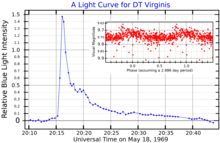DT Virginis, also known as Ross 458, is a binary star system in the constellation of Virgo. It has an apparent visual magnitude of 9.79[2] and is located at a distance of 37.6 light-years from the Sun. Both of the stars are low-mass red dwarfs with at least one of them being a flare star. This binary system has a circumbinary sub-stellar companion.

This star was mentioned as a suspected variable by M. Petit in 1957.[13] In 1960, O. J. Eggen classified it as a member of the Hyades moving group based on the system's space motion;[14] it is now considered a likely member of the Carina Near Moving Group.[5] Two flares were reported from this star in 1969 by N. I. Shakhovskaya, confirming it as a flare star.[11] It was identified as an astrometric binary in 1994 by W. D. Heintz, who found a period of 14.5 years.[4] The pair were resolved using adaptive optics in 1999.[4] Early mass estimates placed the companion near the substellar limit, and it was initially proposed as a brown dwarf[15] but is now considered late-type red dwarf.[3]
The primary member, component A, is an M-type main-sequence star with a stellar classification of M0.5.[3] It is young, magnetically very active star with a high rate of rotation[15] and strong Hα emission.[3] The star experiences star spots that cover 10–15% of the surface[2] It is smaller and less massive than the Sun. The star is radiating just 4.4%[6] of the luminosity of the Sun from its photosphere at an effective temperature of 3,484 K.[5]
Planetary system
A distant sub-stellar companion to the binary star system was discovered in 2010 as part of a deep infrared sky survey. This is most likely a T8 spectral type brown dwarf with an estimated rotation period of 6.75±1.58 h. The object varies slightly in brightness, which may be due to patchy clouds.[3] The companion lacks a detectable oxygen in the atmosphere, implying its formation from sequestrated source or peculiar atmospheric chemistry.[16]
| Companion (in order from star) |
Mass | Semimajor axis (AU) |
Orbital period (years) |
Eccentricity | Inclination | Radius |
|---|---|---|---|---|---|---|
| C | 11.3 ± 4.5 MJ | 1,168.0 | — | — | — | — |
See also
- CM Draconis
- GU Piscium b
- HD 106906 b
- Kepler-16
- Lists of exoplanets
- NN Serpentis
- QS Virginis
- WD 0806-661
References
- ^ a b c d e Vallenari, A.; et al. (Gaia collaboration) (2023). "Gaia Data Release 3. Summary of the content and survey properties". Astronomy and Astrophysics. 674: A1. arXiv:2208.00211. Bibcode:2023A&A...674A...1G. doi:10.1051/0004-6361/202243940. S2CID 244398875. Gaia DR3 record for this source at VizieR.
- ^ a b c d e Alekseev, I. Y.; Bondar, N. I. (1997). "Spottedness of the emission-line dwarf stars BF CVn, DT Vir, EQ Vir, and V1396 Cyg from photoelectric and photographic observations". Astronomy Letters. 23 (2): 257–262. Bibcode:1997AstL...23..257A. Retrieved 2021-11-30.
- ^ a b c d e f Manjavacas, Elena; et al. (April 2019). "Cloud Atlas: Rotational Spectral Modulations and Potential Sulfide Clouds in the Planetary-mass, Late T-type Companion Ross 458C". The Astrophysical Journal Letters. 875 (2): 7. arXiv:1903.10702. Bibcode:2019ApJ...875L..15M. doi:10.3847/2041-8213/ab13b9. S2CID 85518395. L15.
- ^ a b c d e Laugier, R.; et al. (March 2019). "Recovering saturated images for high dynamic kernel-phase analysis. Application to the determination of dynamical masses for the system Gl 494AB". Astronomy & Astrophysics. 623: 8. arXiv:1901.02824. Bibcode:2019A&A...623A.164L. doi:10.1051/0004-6361/201834387. S2CID 119495214. A164.
- ^ a b c d Houdebine, E. R. (September 2010). "Observation and modelling of main-sequence star chromospheres - XIV. Rotation of dM1 stars". Monthly Notices of the Royal Astronomical Society. 407 (3): 1657–1673. Bibcode:2010MNRAS.407.1657H. doi:10.1111/j.1365-2966.2010.16827.x.
- ^ a b c d Khata, Dhrimadri; et al. (April 2020). "Understanding the physical properties of young M dwarfs: NIR spectroscopic studies". Monthly Notices of the Royal Astronomical Society. 493 (3): 4533–4550. arXiv:2002.05762. Bibcode:2020MNRAS.493.4533K. doi:10.1093/mnras/staa427.
- ^ Küker, M.; et al. (2019). "Cycle period, differential rotation and meridional flow for early M dwarf stars". Astronomy & Astrophysics. 622: A40. arXiv:1804.02925. Bibcode:2019A&A...622A..40K. doi:10.1051/0004-6361/201833173. S2CID 118842388.
- ^ Fouqué, Pascal; et al. (April 2018). "SPIRou Input Catalogue: global properties of 440 M dwarfs observed with ESPaDOnS at CFHT". Monthly Notices of the Royal Astronomical Society. 475 (2): 1960–1986. arXiv:1712.04490. Bibcode:2018MNRAS.475.1960F. doi:10.1093/mnras/stx3246.
- ^ Feng, Fabo; Butler, R. Paul; et al. (August 2022). "3D Selection of 167 Substellar Companions to Nearby Stars". The Astrophysical Journal Supplement Series. 262 (21): 21. arXiv:2208.12720. Bibcode:2022ApJS..262...21F. doi:10.3847/1538-4365/ac7e57. S2CID 251864022.
- ^ "DT Virginis". SIMBAD. Centre de données astronomiques de Strasbourg. Retrieved 2019-09-07.
- ^ a b Shakhovskaya, N. I. (July 1969). "Flares of BD +13 2618". Information Bulletin on Variable Stars. 361: 1. Bibcode:1969IBVS..361....1S.
- ^ Kiraga, M. (March 2012). "ASAS Photometry of ROSAT Sources. I. Periodic Variable Stars Coincident with Bright Sources from the ROSAT All Sky Survey". Acta Astronomica. 62 (1): 67–95. arXiv:1204.3825. Bibcode:2012AcA....62...67K. Retrieved 2 May 2022.
- ^ Petit, M. (October 1957). "On the International Cooperation for the Study of Flare Variable Stars". Soviet Astronomy. 1: 783. Bibcode:1957SvA.....1..783P.
- ^ Eggen, Olin J. (1960). "Stellar Groups, VII. The Structure of the Hyades Group". Monthly Notices of the Royal Astronomical Society. 120 (6): 540–62. Bibcode:1960MNRAS.120..540E. doi:10.1093/mnras/120.6.540.
- ^ a b Beuzit, J. -L.; et al. (October 2004). "New neighbours. III. 21 new companions to nearby dwarfs, discovered with adaptive optics". Astronomy and Astrophysics. 425: 997–1008. arXiv:astro-ph/0106277. Bibcode:2004A&A...425..997B. doi:10.1051/0004-6361:20048006. S2CID 15398860.
- ^ Gaarn, Josefine; Burningham, Ben; Faherty, Jacqueline K.; Visscher, Channon; Marley, Mark S.; Gonzales, Eileen C.; Calamari, Emily; Bardalez Gagliuffi, Daniella; Lupu, Roxana; Freedman, Richard (2023), "The puzzle of the formation of T8 dwarf Ross 458c", Monthly Notices of the Royal Astronomical Society, 521 (4): 5761–5775, arXiv:2303.16863, doi:10.1093/mnras/stad753
- ^ Schneider, J. "Notes for Ross 458(AB)". Extrasolar Planets Encyclopaedia. Archived from the original on 2011-10-06.


Recent Comments